The NiCd of NiCad (short for nickel-cadmium) battery is one battery form that has gained wide application since it emerged towards the end of the 19th century. Invented at the beginning of the 19th century, batteries have become a mainstay of the global economy.
Since then, apart from the NiCd battery, many other battery forms have also evolved. These include the lithium-ion battery, NiMH battery, and others. Each battery type has its unique characteristics but this article is entirely focused on the NiCd battery and its various benefits.
1. What is a nickel-cadmium battery and how does it work?
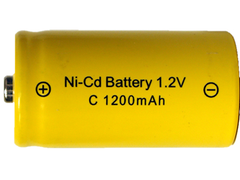
A nickel-cadmium battery is a secondary rechargeable battery made with various compositions of nickel and cadmium. This explains why the battery’s name is derived from the chemical symbols of both substances, (ni) and (cd) respectively. Its rechargeable nature implies an ability to cycle repeatedly.
The first wet cell NiCd battery was built in 1899 by a Swedish scientist. Way back then, nickel was contained in electrodes that were constructed in such a way as to enable a nickel-cadmium compound to conduct electricity.
Long years of research and scientific scrutiny after those early days yielded improvements in both design and functionality. For instance, scientists discovered that providing extra surface area inside a NiCd battery brought about stronger electric currents.
This valuable insight eventually made the battery’s interior to be designed to look like a “jelly roll.” The design was characterized by porous positive electrode (cathode) and negative electrode (anode) plates positioned in-between a separator and then rolled up to produce electric charge and the highest possible power supply.
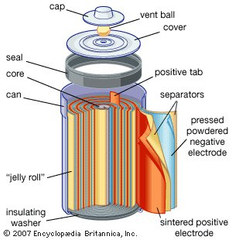
By the mid-1990s, the NiCd battery had risen in status to become the dominant rechargeable battery in the home electronics market. This popularity trend continued and by 2000, a total of 1.5 billion NiCd battery units were in circulation globally. NiCd batteries are usually classified according to size and usable voltage. Such classifications include the AAA, AA, A, Cs, C, D, and F varieties.
Basically, a NiCd battery works by converting chemical energy to electrical energy when discharging and then converting electrical energy back to chemical energy as it recharges. The battery’s positive electrode utilizes nickel oxide while the negative electrode uses cadmium compound. The electrolyte is made of an alkaline solution known as potassium hydroxide (KOH).
However, a completely discharged NiCd battery will be composed of nickel hydroxide, Ni(OH)2 in its positive electrode, and cadmium hydroxide, Cd(OH)2 in its negative electrode. But when charged, the nickel hydroxide in the positive electrode transforms into nickel oxyhydroxide [NiOOH] while the cadmium hydroxide in the negative electrode changes to ordinary cadmium.
This composition is then reversed during another round of discharging, as the cycle continues. The reversal process is captured in the following chemical equation:
Cd + 2H2O + 2NiOOH —> 2Ni(OH)2 + Cd(OH)2
👍2. Some advantages of NiCd batteries include:
- Low internal resistance
- Do not easily overheat (due to low internal resistance)
- Rechargeable
- Constant voltage output (a steady 1.2 volts) even with a low charge. Hence, a NiCd battery has a much slower terminal voltage and its performance level is not influenced by very high discharge currents
- Unlike lithium and NiMH batteries, NiCd batteries can cope better with being float or trickle charged indefinitely
- Relatively more affordable than other more recent battery technologies:NiCd batteries have a high energy density, which means they can store a large amount of energy in a small package.
- Faster charging and discharging rates (also due to low internal resistance)
- Higher cycle life (up to 500 cycles and more),NiCd batteries have a long cycle life and can be recharged many times before they need to be replaced.
- Unlike other brands, a NiCd battery can withstand abuse (e.g., overcharging, undercharging, over-discharging, etc) without any problems
- Higher energy density when compared with lead-acid batteries
- Can be completely discharged up to zero volts and stored without any problems, unlike the less stable lithium-ion batteries that cannot be discharged beyond a minimum level without being permanently damaged
- In contrast to popular opinion, a memory effect will not exist in NiCd batteries that are properly charged and discharged
- NiCd batteries are easier to produce and come in a variety of types, forms, and sizes
- Low maintenance: NiCd batteries do not require frequent maintenance, which makes them easy to use and less prone to malfunction.
3. What are NiCd batteries used for?
🧰Power tools
Cordless power tools are one area that the NiCd battery is very popularly used. By their very nature, power tools require tough batteries with stable long-lasting power output in order to perform efficiently and at maximum capacity.
The NiCd battery is not only tough but will also generate steady power over long periods without declines in voltage than any other battery. They will also charge faster than other battery options.
⌨Wireless devices
NiCd batteries are an efficient and durable power source for power-consuming devices such as walkie-talkies and cordless phones which tend to utilize more resources than conventional mobile phones.
🔦Emergency lighting
Appliances like flashlights are very suitable for NiCd batteries not only because of their quality output but also because of their ability to be trickle-charged for long durations.
🚜RC vehicles
NiCd batteries are commonly used in RC vehicles like cars, airplanes, and boats because of their conformity with crucial variables such as power, size weight, and longevity.
🔋Industrial uses
Among the industrial use cases of NiCd batteries include satellite/telecommunications technologies, UPS equipment, electronics, digital cameras, generators, and portable devices such as medical equipment, among others.
4. Where to get quality Nickel batteries?
With the difficult socio-economic conditions brought about by the global pandemic, you want to make sure that you purchase the highest quality nickel-cadmium batteries that provide efficient service whilst having a long shelf life. This is where EBL Official can help. EBL is an experienced market leader in the field of battery and charger manufacturing. Below are some high-quality NiCd batteries available at EBL.
🔋EBL C rechargeable nicd battery [1.2v; 4000mAh]
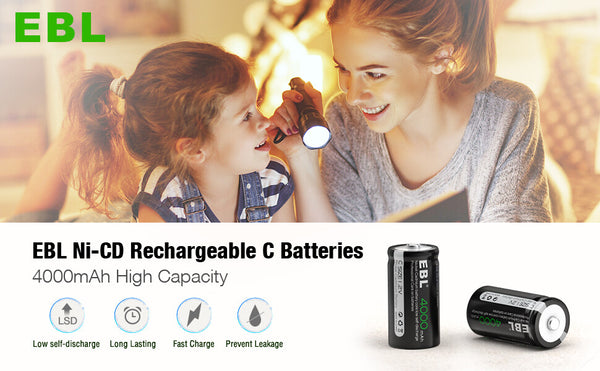
A high-quality NiCd battery that yields a much improved high-temperature performance than other battery types. It can be used in temperatures ranging from -4℉ to 140℉ and can be charged via sunshine, and even under snowy conditions. This is one EBL battery that is economical, has a long shelf life, comes with an increased capacity to retain electric charge, in addition to having a recharge cycle of up to 1200 times.
🔋EBL Sub C NiCd Rechargeable Batteries [1.2V 2300mAh]
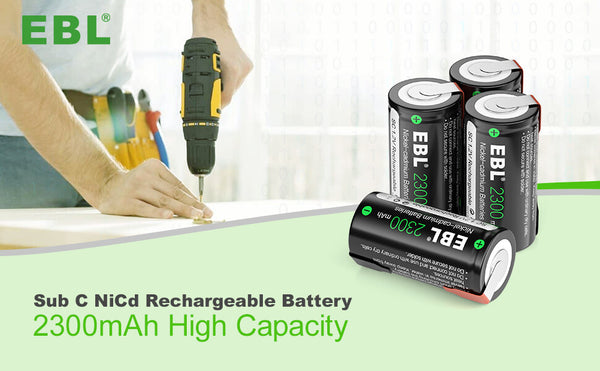
This EBL Sub C 1.2V 2300mAh Rechargeable Nickel-cadmium battery have a high cycle life as they can be charged up to 600 times. Up to a 600 cycle life rate ensures that the battery will continue to enhance the performance of the high drain devices and save your money.
🔋EBL AA rechargeable Nicd batteries [1.2v; 1100 mAh]
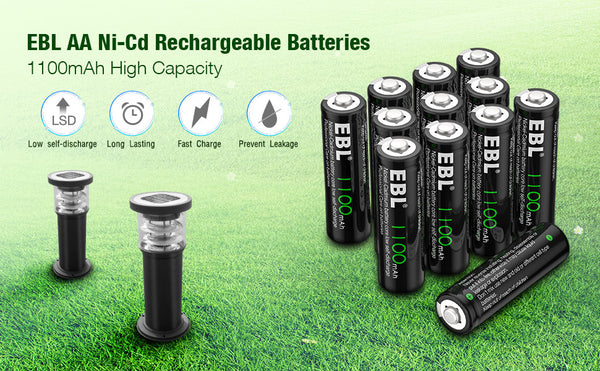
This EBL NiCd battery comes is designed with a Professional ProCyco Technology that is characterized by a superlattice alloy, high retention rate of electric charge, low loss of capacity, and an excellent discharge performance at high temperatures. It can be recharged as many as1200 times.
🔋EBL AAA Ni-Cd Rechargeable Batteries [1.2V 500mAh]
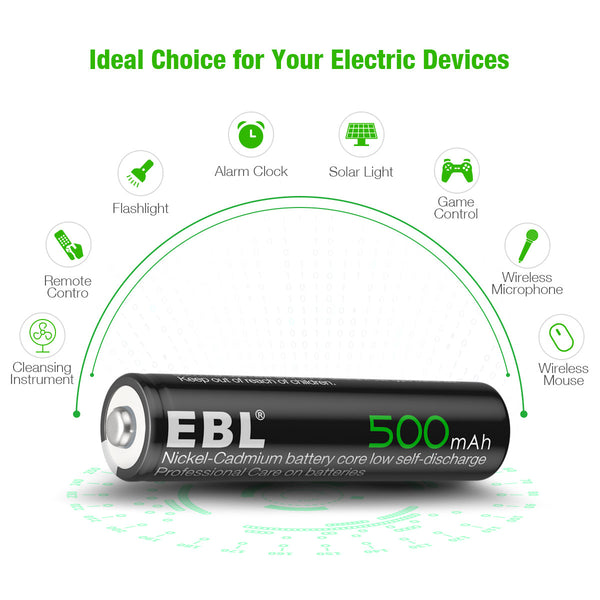
These slender high-quality NiCd batteries come in a pack of 20 and are designed with advanced technology. They are a perfect replacement for the old batteries in your solar light as well as for those devices that drain batteries at a faster rate. Like both batteries above, they can also be recharged up to 1200 times and more, amongst other attractive qualities.
If you are in need of efficient, affordable, safe, and long-lasting NiCd batteries, then do not procrastinate, contact EBL now. EBL boasts the ultra-modern facilities and technologies that will provide optimal solutions for all your battery challenges!





Leave a comment
All comments are moderated before being published.
This site is protected by hCaptcha and the hCaptcha Privacy Policy and Terms of Service apply.